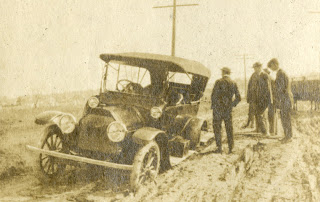In May 1837 the new Republic of Texas awarded a municipal charter to Richmond, Texas. A few months later in the same year, Congress designated Richmond as the seat of government for newly formed Fort Bend County. If you do the math, you'll note that Richmond and Fort Bend County are 175-years old this year.
Richmond's start came in 1822 when a party of scouts led by William Little made their way up the Brazos. They built a fort in the 'big bend' of the river. Eventually, members of Stephen F. Austin's colony settled the area. By the time the Revolution came it was a prominent settlement. Here is a link to The Handbook of Texas if you want to read more.
I've spent a lot of time at another good Web site, Portal to Texas History, which contains many historic photos and documents. Here is the first mention of Richmond, Texas in a newspaper - look near the top of the middle column. It appeared in the Telegraph and Texas Register published in Columbia on April 4, 1837. I've included the following clip if you have trouble finding it.
Robert Eden Handy and William Lusk had operated a store in Brazoria. This ad publicized their relocation from Brazoria to the new town of Richmond.
Once they had settled in Richmond, Handy and Lusk started wheeling and dealing. They and other entrepreneurs began selling real estate in the new town. This is ad appeared in the Telegraph & Texas Register, published in Houston on Saturday, August 5, 1837. See the top of the middle column. Notice the paper had also relocated to another potential boom town in the Republic.
I've posted this clip in case you have trouble finding the second ad.
Much of what you see in Fort Bend County today started a mere 175 years ago.
I've spent a lot of time at another good Web site, Portal to Texas History, which contains many historic photos and documents. Here is the first mention of Richmond, Texas in a newspaper - look near the top of the middle column. It appeared in the Telegraph and Texas Register published in Columbia on April 4, 1837. I've included the following clip if you have trouble finding it.
Robert Eden Handy and William Lusk had operated a store in Brazoria. This ad publicized their relocation from Brazoria to the new town of Richmond.
Once they had settled in Richmond, Handy and Lusk started wheeling and dealing. They and other entrepreneurs began selling real estate in the new town. This is ad appeared in the Telegraph & Texas Register, published in Houston on Saturday, August 5, 1837. See the top of the middle column. Notice the paper had also relocated to another potential boom town in the Republic.
I've posted this clip in case you have trouble finding the second ad.
Much of what you see in Fort Bend County today started a mere 175 years ago.

















